According to a recent study by the World Bank, “Long-Term Drivers of Food Prices,” oil prices are the biggest driver of higher food prices. The study, using data from 1960-2012, applied an economic model to five internationally-traded food commodities (maize/corn, wheat, rice, soybeans and palm oil) and studied the impact of several food-price drivers. These included energy prices, exchange rates, interest rates, inflation, income and a variable reflecting  market fundamentals.
market fundamentals.
The study also paid special attention to two time periods: 1997-2004 and 2005-2007. Between the two time frames, the price of energy, fertilizers and precious metals tripled. In addition, most food prices doubled. Of all the drivers of food prices, crude oil prices had the biggest impact.
Tom Buis, CEO of Growth Energy noted that also during this time, food and energy price increases also coincided with record profits for the oil industry.
“Not only has the oil industry been responsible for the sky-rocketing gas prices each time you fill up your car, now it turns out they are responsible for the price increases you face at the grocery store. While they enjoy record profits, populations around the world suffer at their expense and struggle to pay for the basic staples of life.”
“The World Bank found that crude oil is responsible for more than half of the increase in food prices,” Buis added. “Couple that with the nearly 100 percent increase in domestic gas prices over the same time frame, and the cost of oil has truly affected the well-being of all Americans in a very expensive way.”

